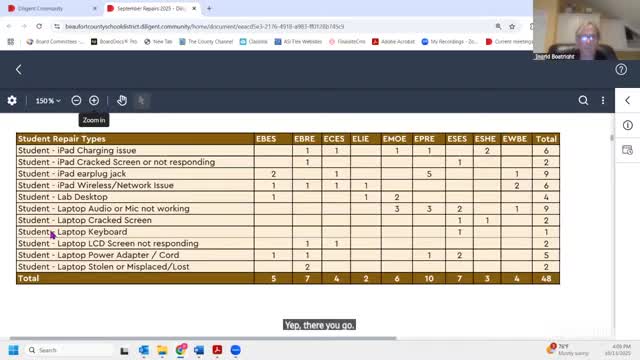Committee details four-part technology survey; staff to revise and seek board approval
October 13, 2025 | Beaufort 01, School Districts, South Carolina
This article was created by AI summarizing key points discussed. AI makes mistakes, so for full details and context, please refer to the video of the full meeting. Please report any errors so we can fix them. Report an error »

Beaufort County School Board Technology Committee members spent the bulk of their Oct. 13 meeting refining four technology surveys for community members, parents, staff and students and set a timeline to present the revised surveys to the full board for approval.
Mister Shohan, staff member, said the district plans separate surveys for community members, parents, teachers/administrators and students and that he had combined teacher and staff surveys for review. "Weve talked about how we could . . . use more of a free-text survey," Shohan said, describing an approach that relies on open-ended responses rather than only scaled Likert questions.
Committee members suggested edits and question clarifications. Possible survey topics the group agreed should align across audience groups included workforce readiness, equity and access, community value/impact, AI in the classroom and future skills. Members asked that "1-to-1" program language be defined for nontechnical respondents.
The committee discussed question wording and level of prompting. Several members recommended adding a required "why or why not" free-text follow-up to yes/no questions about AI and technology so responses provide context. Miss Hay, committee member, urged the group to include specific behavioral questions to prompt parents to report observable effects (for example, agitation after device use), noting that parents vary in awareness of technologys impacts.
The group also debated the student survey population. Shohan recommended focusing the student survey on grades 6–12. Committee members supported that recommendation; one member noted younger children may produce responses that reflect parent input rather than the childs own views. The committee discussed distribution channels: the districts new survey tool for community members and SurveyMonkey or Canvas for student distribution, plus outreach through school improvement councils (SICs), the Chamber of Commerce and other local partners.
Members recommended collecting limited, optional demographic data (grade, school, broad age ranges, ZIP code or closest school and very general occupation categories such as hospitality, healthcare, technology or military/retired) to allow analysis of trends by location, age or occupation without requiring personally identifying information. Shohan said the districts survey product can provide raw data dumps or CSV exports suitable for later analysis.
Timeline and next steps: Shohan said he would revise the surveys and send them back to the committee by Wednesday or Thursday for final feedback. The committee plans to present the survey instrument to the full board at its next meeting; the committee referenced the board meeting on Oct. 21 as the target for approval and kickoff. No board approval was recorded at this meeting.
Ending: Committee members asked staff to draft a brief preamble and definitions for the survey instrument, finalize question wording, and include an optional demographic section; staff will return revised drafts for committee review before board presentation.
Mister Shohan, staff member, said the district plans separate surveys for community members, parents, teachers/administrators and students and that he had combined teacher and staff surveys for review. "Weve talked about how we could . . . use more of a free-text survey," Shohan said, describing an approach that relies on open-ended responses rather than only scaled Likert questions.
Committee members suggested edits and question clarifications. Possible survey topics the group agreed should align across audience groups included workforce readiness, equity and access, community value/impact, AI in the classroom and future skills. Members asked that "1-to-1" program language be defined for nontechnical respondents.
The committee discussed question wording and level of prompting. Several members recommended adding a required "why or why not" free-text follow-up to yes/no questions about AI and technology so responses provide context. Miss Hay, committee member, urged the group to include specific behavioral questions to prompt parents to report observable effects (for example, agitation after device use), noting that parents vary in awareness of technologys impacts.
The group also debated the student survey population. Shohan recommended focusing the student survey on grades 6–12. Committee members supported that recommendation; one member noted younger children may produce responses that reflect parent input rather than the childs own views. The committee discussed distribution channels: the districts new survey tool for community members and SurveyMonkey or Canvas for student distribution, plus outreach through school improvement councils (SICs), the Chamber of Commerce and other local partners.
Members recommended collecting limited, optional demographic data (grade, school, broad age ranges, ZIP code or closest school and very general occupation categories such as hospitality, healthcare, technology or military/retired) to allow analysis of trends by location, age or occupation without requiring personally identifying information. Shohan said the districts survey product can provide raw data dumps or CSV exports suitable for later analysis.
Timeline and next steps: Shohan said he would revise the surveys and send them back to the committee by Wednesday or Thursday for final feedback. The committee plans to present the survey instrument to the full board at its next meeting; the committee referenced the board meeting on Oct. 21 as the target for approval and kickoff. No board approval was recorded at this meeting.
Ending: Committee members asked staff to draft a brief preamble and definitions for the survey instrument, finalize question wording, and include an optional demographic section; staff will return revised drafts for committee review before board presentation.
View full meeting
This article is based on a recent meeting—watch the full video and explore the complete transcript for deeper insights into the discussion.
View full meeting